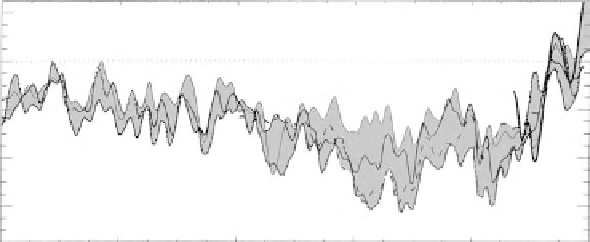Geoscience Reference
In-Depth Information
Figure 8.1 ''Envelope''
of reconstructions of NH
temperature variations
between AD 1000
and 2000, from five
interpretations of proxy and
measured data on 50-year
time scales. The data are
calculated as anomalies
from the 1961-90 global
average. The envelope
obscures the details from
each of the interpretations,
but emphasizes the
temperature variations over
time. The greatest range in
the estimates occurs in the
middle of the Little Ice Age,
from about 1550 to 1800.
(Adapted from Jones et al.
2001
; for further details
0.2
0.0
-0.2
-0.4
-0.6
1000
1200
1400
1600
1800
2000
Year (AD)
of a significant climate change period; and the seventeeth century, when colder,
stormier conditions were dominant. Section
8.4
, the essay by Changnon,
explores the relationship between climate variations and economics in the
United States in modern times.
Diaz et al.(
2001
) emphasize that one of the fundamental impacts of climate
change is on food production. Over the short term, over perhaps one to five
years, climate variations can disrupt food supplies and create famine, causing
considerable social unrest, until the society adjusts or the climate improves
again. Over the long term, perhaps 10 years or more, climate change can threaten
the viability of civilizations through loss of food and water resources, creating
the need for radical change, or even leading to the breakdown of the society
(Burroughs
1997
). These climate impacts can be exacerbated by human activity,
and are uniform neither spatially nor temporally across the globe. Much is still
unclear about how and to what degree both large and small societies are vulner-
able to climate changes and variations.
8.2 The Viking settlements in Greenland, AD 800-1450
8.2.1 Introduction
Between 800 and 1450 was a period of major change and movement in popula-
tions around the globe, encompassing the rise and fall of some great civiliza-
tions. The Mayan Classic period on the Yucatan Peninsula in Mexico occurred
between 300 and 900, followed by the Toltecs in the tenth to twelfth centuries.
In Cambodia, the Khmer Empire was founded in the ninth century and peaked
during 1100 with the building of Angkor Wat. The Koryo Dynasty ruled in
Korea between 935 and 1250. Germanic and Slavic tribes moved across Europe
between 500 and 900, finally settling in Britain, Italy, and what is now Eastern
Europe. In the thirteenth century, the Mongols conquered all of China and made
major incursions across Asia and into Eastern Europe. Two great ocean mig-
rations occurred during this period. The Polynesians sailed from Samoa and

Search WWH ::

Custom Search